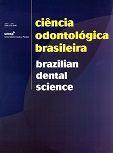Relação entre alteração da dimensão vertical de oclusão e disfunção temporomandibular – avaliação clínica
DOI:
https://doi.org/10.14295/bds.2009.v12i3.633Abstract
Este estudo objetivou pesquisar a relação entre alteração na Dimensão Vertical de Oclusão (DVO) e a possível presença de Disfunção Temporomandibular (DTM). Foram pesquisados 185 pacientes, atendidos na Faculdade de Odontologia da Universidade Estadual da Paraíba. A idade dos pesquisados variou entre 18 e 65 anos, divididos em: Grupo I – com alteração da DVO e DTM; Grupo II – com alteração da DVO sem DTM; Grupo III – sem alteração da DVO com DTM; Grupo IV – sem alteração da DVO sem DTM. A presença de DTM foi detectada pelo Índice Anamnésico Simplificado DMF, classificando os pacientes em: Não DTM, DTM leve, moderada ou severa. A avaliação da DVO foi realizada pelos métodos de Lytle modificado por Tamaki e de Pleasure com averiguação do Espaço Funcional Livre (EFL), sendo classificada em: DVO normal (EFL de 2 a 4mm) ou alterada (diminuída-EFL > 4mm ou aumentada-EFL < 2mm). Utilizaram-se os testes estatísticos Qui-quadrado de Pearson e Exato de Fisher (α = 5%). Houve predominância na amostra do sexo feminino (80,5%), e das faixas etárias de 21-40 (41,6%) e 41-60 anos (49,2%). Obtiveram-se os seguintes valores de n: Grupo I – 62; Grupo II – 29; Grupo III – 62; e Grupo IV – 32. Alteração da DVO foi observada em 49,1% dos pacientes. A prevalência de DTM nos pacientes com alteração de DVO e sem alteração de DVO foi próxima, com 68,1% e 66,0%, respectivamente (p>0,05). Concluiu-se que, apesar da considerável prevalência de DTM nos pacientes com alteração da DVO, estas variáveis não apresentaram associação, não evidenciando relação entre alteração da DVO e presença de DTM.
Downloads
Downloads
Published
How to Cite
Issue
Section
License
Brazilian Dental Science uses the Creative Commons (CC-BY 4.0) license, thus preserving the integrity of articles in an open access environment. The journal allows the author to retain publishing rights without restrictions.
=================




























